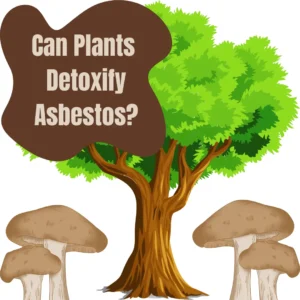Key takeaways: Asbestos has been used for decades in the industrial, construction, and production sectors, but it is strongly associated with the development of mesothelioma. Although asbestos has recently been banned in the United States, it still exists in our water pipes, homes, schools, skyscrapers, and construction sites. There are relatively few methods of safe removal and disposal for asbestos, besides keeping abated asbestos in special landfills or integrating it into the natural landscape. However, recent efforts have been focused on phytoremediation, or the process by which plants, bacteria, and fungi detoxify harmful materials.

Where is asbestos found?
Asbestos is a naturally-occurring mineral that has been widely used for its fire retardant capacities, structural durability, and relatively inexpensive production process. However, airborne asbestos has been associated with mesothelioma, among other serious health conditions. When asbestos becomes airborne, it can be ingested by humans; once ingested, the body isn’t able to destroy or remove the fibers, so chronic inflammation and carcinogenesis (cancer development) ensues.
As of March 2024, the Environmental Protection Agency (EPA) has banned the last kind of asbestos in the U.S.—chrysotile—in hopes of protecting the American public from the dangerous health effects of asbestos. However, extant asbestos still pose an active risk for some Americans, so mitigating the instance of exposure is critical.
What currently mitigates the dangers of asbestos?
When asbestos is abated, or safely removed by a qualified contractor, there are a number of options for recycling, storing, or destroying, although some methods are preferred over others. For now, most abatement specialists opt for either disposal in a landfill or safely incorporating it into revamped natural spaces, like the BoRit site in Ambler, PA. There are landfills that specialize in maintaining conditions that minimize the chance of asbestos escaping. So, most of the mitigation of exposure is just the storage of asbestos in uninhabited places. However, because the “discarded” asbestos still exists in the environment, there’s a chance of environmental contamination via the soil, air, or water supply, even if people do not live close by.
Can phytoremediation help?
Phytoremediation is the utilization of natural sources—like bacteria, fungi, lichen, and plants—in order to mitigate the severity of dangerous materials. As an example, phytoremediation has been used in areas that have high heavy metal levels in soil: the trees, microorganisms, and plants act as filters for the metals and clear the areas naturally. Although this takes a significant amount of time, there aren’t any hazardous effects, extensive costs, or negative impacts on the natural communities surrounding areas of remediation.
For example, the bacterium Acidithiobacillus thiooxidans coupled with the fungus Aspergillus niger breaks down chrysotile asbestos into magnesium (when additional organic compounds, found in the natural environment, were added in the trial). This means that asbestos fibers can be safely destroyed and turned into an entirely different—and usable—material. Lichens also break down asbestos, but do so in a more physical (disaggregating) way via their hyphae (branches): when the hyphae penetrate the asbestos, the mineral properties are disrupted. When asbestos’s mineral properties are disrupted, it becomes significantly less toxic.
There have been a few studies that detail the ways in which bacteria, fungi, or plants detoxify asbestos, but research efforts have largely been focused elsewhere. This could be because research funds are allocated towards technology, even though phytoremediation is more
cost-effective and less environmentally disruptive. Hopefully, phytoremediation will become a feasible option for detoxifying asbestos and making our communities safer.
If you or a loved one has been diagnosed with mesothelioma, please call 1 (800)-505-6000 or fill out our form. We are here to help you navigate the legal process of filing a claim to receive compensation for your mesothelioma diagnosis. We help mesothelioma victims and their families in Pennsylvania.
Sources:
https://www.mdpi.com/1996-1944/17/7/1644
https://www.frontiersin.org/journals/plant-science/articles/10.3389/fpls.2020.00359/full https://www.epa.gov/asbestos/learn-about-asbestos
